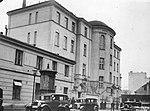Rondo ONZ metro station
2015 establishments in PolandEuropean rapid transit stubsPoland transport stubsRailway stations opened in 2015Warsaw Metro stations ... and 2 more
Warsaw railway station stubsWarsaw stubs

Rondo ONZ is a station on the central part of Line M2 of the Warsaw Metro. The station fully opened for passenger use on 8 March 2015 as part of the inaugural stretch of Line M2 between Rondo Daszyńskiego and Dworzec Wileński. It was designed by Polish architect Andrzej M. Chołdzyński and constructed by Metroprojekt. Murals were created by Wojciech Fangor, artist of the Polish School of Posters. The station is located under the Rondo ONZ, a roundabout situated on the border of downtown and Wola.
Excerpt from the Wikipedia article Rondo ONZ metro station (License: CC BY-SA 3.0, Authors, Images).Rondo ONZ metro station
Rondo ONZ, Warsaw Śródmieście (Warsaw)
Geographical coordinates (GPS) Address Nearby Places Show on map
Geographical coordinates (GPS)
| Latitude | Longitude |
|---|---|
| N 52.233055555556 ° | E 20.998333333333 ° |
Address
Rondo ONZ
00-828 Warsaw, Śródmieście (Warsaw)
Masovian Voivodeship, Poland
Open on Google Maps











